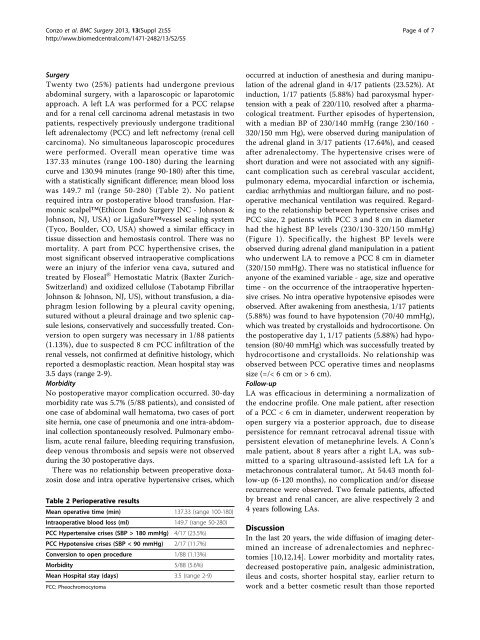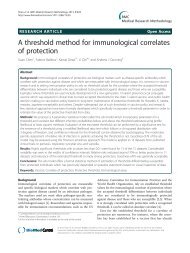Laparoscopic adrenal surgery: ten-year ... - BioMed Central
Laparoscopic adrenal surgery: ten-year ... - BioMed Central
Laparoscopic adrenal surgery: ten-year ... - BioMed Central
Create successful ePaper yourself
Turn your PDF publications into a flip-book with our unique Google optimized e-Paper software.
Conzo et al. BMC Surgery 2013, 13(Suppl 2):S5<br />
http://www.biomedcentral.com/1471-2482/13/S2/S5<br />
Page 4 of 7<br />
Surgery<br />
Twenty two (25%) patients had undergone previous<br />
abdominal <strong>surgery</strong>, with a laparoscopic or laparotomic<br />
approach. A left LA was performed for a PCC relapse<br />
and for a renal cell carcinoma <strong>adrenal</strong> metastasis in two<br />
patients, respectively previously undergone traditional<br />
left <strong>adrenal</strong>ectomy (PCC) and left nefrectomy (renal cell<br />
carcinoma). No simultaneous laparoscopic procedures<br />
were performed. Overall mean operative time was<br />
137.33 minutes (range 100-180) during the learning<br />
curve and 130.94 minutes (range 90-180) after this time,<br />
with a statistically significant difference; mean blood loss<br />
was 149.7 ml (range 50-280) (Table 2). No patient<br />
required intra or postoperative blood transfusion. Harmonic<br />
scalpel(Ethicon Endo Surgery INC - Johnson &<br />
Johnson, NJ, USA) or LigaSurevessel sealing system<br />
(Tyco, Boulder, CO, USA) showed a similar efficacy in<br />
tissue dissection and hemostasis control. There was no<br />
mortality. A part from PCC hyperthensive crises, the<br />
most significant observed intraoperative complications<br />
were an injury of the inferior vena cava, sutured and<br />
treated by Floseal ® Hemostatic Matrix (Baxter Zurich-<br />
Switzerland)andoxidizedcellulose (Tabotamp Fibrillar<br />
Johnson & Johnson, NJ, US), without transfusion, a diaphragm<br />
lesion following by a pleural cavity opening,<br />
sutured without a pleural drainage and two splenic capsule<br />
lesions, conservatively and successfully treated. Conversion<br />
to open <strong>surgery</strong> was necessary in 1/88 patients<br />
(1.13%), due to suspected 8 cm PCC infiltration of the<br />
renal vessels, not confirmed at definitive histology, which<br />
reported a desmoplastic reaction. Mean hospital stay was<br />
3.5 days (range 2-9).<br />
Morbidity<br />
No postoperative mayor complication occurred. 30-day<br />
morbidity rate was 5.7% (5/88 patients), and consisted of<br />
one case of abdominal wall hematoma, two cases of port<br />
site hernia, one case of pneumonia and one intra-abdominal<br />
collection spontaneously resolved. Pulmonary embolism,<br />
acute renal failure, bleeding requiring transfusion,<br />
deep venous thrombosis and sepsis were not observed<br />
during the 30 postoperative days.<br />
There was no relationship between preoperative doxazosin<br />
dose and intra operative hyper<strong>ten</strong>sive crises, which<br />
Table 2 Perioperative results<br />
Mean operative time (min) 137.33 (range 100-180)<br />
Intraoperative blood loss (ml) 149.7 (range 50-280)<br />
PCC Hyper<strong>ten</strong>sive crises (SBP > 180 mmHg) 4/17 (23.5%)<br />
PCC Hypo<strong>ten</strong>sive crises (SBP < 90 mmHg) 2/17 (11.7%)<br />
Conversion to open procedure 1/88 (1.13%)<br />
Morbidity 5/88 (5.6%)<br />
Mean Hospital stay (days) 3.5 (range 2-9)<br />
PCC: Pheochromocytoma<br />
occurred at induction of anesthesia and during manipulation<br />
of the <strong>adrenal</strong> gland in 4/17 patients (23.52%). At<br />
induction, 1/17 patients (5.88%) had paroxysmal hyper<strong>ten</strong>sion<br />
with a peak of 220/110, resolved after a pharmacological<br />
treatment. Further episodes of hyper<strong>ten</strong>sion,<br />
with a median BP of 230/140 mmHg (range 230/160 -<br />
320/150 mm Hg), were observed during manipulation of<br />
the <strong>adrenal</strong> gland in 3/17 patients (17.64%), and ceased<br />
after <strong>adrenal</strong>ectomy. The hyper<strong>ten</strong>sive crises were of<br />
short duration and were not associated with any significant<br />
complication such as cerebral vascular accident,<br />
pulmonary edema, myocardial infarction or ischemia,<br />
cardiac arrhythmias and multiorgan failure, and no postoperative<br />
mechanical ventilation was required. Regarding<br />
to the relationship between hyper<strong>ten</strong>sive crises and<br />
PCC size, 2 patients with PCC 3 and 8 cm in diameter<br />
had the highest BP levels (230/130-320/150 mmHg)<br />
(Figure 1). Specifically, the highest BP levels were<br />
observed during <strong>adrenal</strong> gland manipulation in a patient<br />
who underwent LA to remove a PCC 8 cm in diameter<br />
(320/150 mmHg). There was no statistical influence for<br />
anyone of the examined variable - age, size and operative<br />
time - on the occurrence of the intraoperative hyper<strong>ten</strong>sive<br />
crises. No intra operative hypo<strong>ten</strong>sive episodes were<br />
observed. After awakening from anesthesia, 1/17 patients<br />
(5.88%) was found to have hypo<strong>ten</strong>sion (70/40 mmHg),<br />
which was treated by crystalloids and hydrocortisone. On<br />
the postoperative day 1, 1/17 patients (5.88%) had hypo<strong>ten</strong>sion<br />
(80/40 mmHg) which was successfully treated by<br />
hydrocortisone and crystalloids. No relationship was<br />
observed between PCC operative times and neoplasms<br />
size (=/< 6 cm or > 6 cm).<br />
Follow-up<br />
LA was efficacious in determining a normalization of<br />
the endocrine profile. One male patient, after resection<br />
of a PCC < 6 cm in diameter, underwent reoperation by<br />
open <strong>surgery</strong> via a posterior approach, due to disease<br />
persis<strong>ten</strong>ce for remnant retrocaval <strong>adrenal</strong> tissue with<br />
persis<strong>ten</strong>t elevation of metanephrine levels. A Conn’s<br />
male patient, about 8 <strong>year</strong>s after a right LA, was submitted<br />
to a sparing ultrasound-assisted left LA for a<br />
metachronous contralateral tumor,. At 54.43 month follow-up<br />
(6-120 months), no complication and/or disease<br />
recurrence were observed. Two female patients, affected<br />
by breast and renal cancer, are alive respectively 2 and<br />
4 <strong>year</strong>s following LAs.<br />
Discussion<br />
In the last 20 <strong>year</strong>s, the wide diffusion of imaging determined<br />
an increase of <strong>adrenal</strong>ectomies and nephrectomies<br />
[10,12,14]. Lower morbidity and mortality rates,<br />
decreased postoperative pain, analgesic administration,<br />
ileus and costs, shorter hospital stay, earlier return to<br />
work and a better cosmetic result than those reported
















